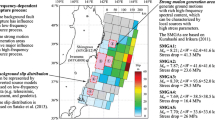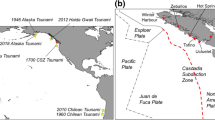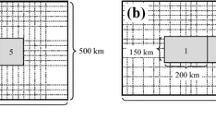Abstract
Deterministic analysis of local tsunami generated by subduction zone earthquakes demonstrates the potential for extensive inundation and building damage in Napier, New Zealand. We present the first high-resolution assessments of tsunami inundation in Napier based on full simulation from tsunami generation to inundation and demonstrate the potential variability of onshore impacts due to local earthquakes. In the most extreme scenario, rupture of the whole Hikurangi subduction margin, maximum onshore flow depth exceeds 8.0 m within 200 m of the shore and exceeds 5.0 m in the city centre, with high potential for major damage to buildings. Inundation due to single-segment or splay fault rupture is relatively limited despite the magnitudes of MW 7.8 and greater. There is approximately 30 min available for evacuation of the inundation zone following a local rupture, and inundation could reach a maximum extent of 4 km. The central city is inundated by up to three waves, and Napier Port could be inundated repeatedly for 12 h. These new data on potential flow depth, arrival time and flow kinematics provide valuable information for tsunami education, exposure analysis and evacuation planning.









Similar content being viewed by others
References
Abe K (1975) Reliable estimation of the seismic moment of large earthquakes. J Phys Earth 23:381–390
Amante C, Eakins BW (2009) ETOPO1 1 Arc-minute global relief model: procedures, data sources and analysis. NOAA Technical Memorandum NESDIS NGDC-24, 19 p, March 2009. http://www.ngdc.noaa.gov/mgg/global
Ansell JH, Bannister SC (1996) Shallow morphology of the subducted Pacific plate along the Hikurangi margin, New Zealand. Phys Earth Planet In 93:3–20
Arcement GJ, Schneider VR (1989) Guide for selecting manning’s roughness coefficients for natural channels and flood plains. United States Geological Survey Water-supply Paper 2339, Denver, CO. 38p. http://www.fhwa.dot.gov/bridge/wsp2339.pdf
Baptista MA, Miranda JM, Omira R, Antunes C (2011) Potential inundation of Lisbon downtown by a 1755-like tsunami. Nat Hazards Earth Syst Sci 11(12):3319–3326. doi:10.5194/nhess-11-3319-2011
Barker DHN, Sutherland R, Henrys S, Bannister S (2009) Geometry of the Hikurangi subduction thrust and upper plate, North Island, New Zealand. Geochem Geophys Geosyst 10(2). doi: 10.1029/2008GC002153
Barnes PM, Nicol A, Harrison T (2002) Late Cenozoic evolution and earthquake potential of an active listric thrust complex above the Hikurangi subduction zone. New Zealand. Geol Soc Am Bull 114(11):1379–1405
Bell R, Sutherland R, Barker DHN, Henrys S, Bannister S, Wallace L, Beavan J (2010) Seismic reflection character of the Hikurangi subduction interface, New Zealand, in the region of repeated Gisborne slow slip events. Geophys J Int 180(1):34–48
Berryman KR (1993) Age, height, and deformation of Holocene marine terraces at Mahia Peninsula, Hikurangi Subduction Marginm, New Zealand. Tectonics 12(6):1347–1364. doi:10.1029/93TC01542
Berryman KR (2005) (compiler) Review of Tsunami Hazard and Risk in New Zealand. Institute of Geological & Nuclear Sciences Limited. Client report 2005/104. Lower Hutt, New Zealand. http://www.civildefence.govt.nz/memwebsite.nsf/Files/Tsunami_Hazard_report/$file/Final_Hazard_and_Risk_Report-web.pdf
Berryman KR, Ota Y, Hull AG (1989) Holocene paleoseismicity in the fold and thrust belt of the Hikurangi subduction zone, eastern North Island, New Zealand. Tectonophysics 163(3–4):185–195
Berryman KR, Ota Y, Miyauchi T, Hull AG, Clark K, Ishibashi K, Iso N, Litchfield N (2011) Holocene paleoseismic history of upper-plate faults in the Southern Hikurangi Subduction Margin, New Zealand, deduced from marine terrace records. Bull Seismol Soc Am 101(5):2064–2087
Chagué-Goff C, Dawson S, Goff JR et al (2002) A tsunami (ca. 6300 years BP) and other Holocene environmental changes, northern Hawke’s Bay, New Zealand. Sediment Geol 150(1–2): 89–102
Cho Y-S (1995) Numerical simulation of tsunami and run-up. Dissertation. Cornell University
Clark K, Berryman K, Litchfield N, Cochran UA, Little T (2010) Evaluating the coastal deformation mechanisms of the Raukumara Peninsula, northern Hikurangi subduction margin, New Zealand and insights into forearc uplift processes. N Z J Geol Geophys 53(4):341–358
Cochran UA, Berryman KR, Mildenhall DC, Hayward BW, Southall K (2005) Towards a record of Holocene tsunami and storms for northern Hawke’s Bay, New Zealand. N Z J Geol Geophys 48(3):507–515
Cochran UA, Berryman KR, Zachariasen J et al (2006) Paleoecological insights into subduction zone earthquake occurrence, eastern North Island, New Zealand. Geol Soc Am Bull 118(9–10):1051–1074
Collot J-Y, Lewis KB, Lamarche G, Lallemand SE (2001) The giant Ruatoria debris avalanche on the northern Hikurangi margin, New Zealand; results of oblique seamount subduction. J Geophys Res-Solid 106(9):19271–19297
Cousins WJ (2009) RiskScape–development of a default assets model for Hawke’s Bay. GNS Science Consultancy Report 2009/50. Lower Hutt, New Zealand. 29p
De Lange WP, Healy TR (1986) New Zealand tsunamis 1840–1982. N Z J Geol Geophys 29(1):115–134
Downes GL (2006) The 1904 MS6.8 MW7.0–7.2 Cape Turnagain, New Zealand, earthquake. B New Zealand Soc Earthq Eng 39(4):182–207
Downes GL, Webb T, McSaveney M et al (2000) The 26 March and 17 May 1947 Gisborne earthquakes and tsunami: implications for tsunami hazard for the east coast, North Island, New Zealand. In: Proceedings of the international tsunami workshop tsunami risk assessment beyond 2000: Theory, Practice and Plans, pp 55–67
Fraser RJ (1998) Historical Tsunami Database for New Zealand. Dissertation. Waikato University, Hamilton
Gayer G, Leschka S, Nöhren I, Larsen O, Günther H (2010) Tsunami inundation modelling based on detailed roughness maps of densely populated areas. Nat Hazards Earth Syst Sci 10(8):1679–1687. doi:10.5194/nhess-10-1679-2010
GEBCO (2008). The GEBCO_08 Grid. http://www.gebco.net/data_and_products/gridded_bathymetry_data/
Goff JR (2008) Tsunami Hazard Assessment for Hawke’s Bay Region. Christchurch, New Zealand. NIWA Client Report: CHC2008-021. National Institute of Water & Atmospheric Research Ltd, Christchurch, New Zealand
Goto K, Chagué-Goff C, Goff JR, Jaffe BE (2012) The future of tsunami research following the 2011 Tohoku-oki event. Sediment Geol 282:1–13. doi:10.1016/j.sedgeo.2012.08.003
Hawke’s Bay CDEM Group (2011) Latest hazard maps inform tsunami preparedness. http://www.hbemergency.govt.nz/PicsHotel/HawkesBayCDEM/Brochure/Hazards/TsunamiHazardMaps.pdf
Hawke’s Bay Regional Council (2010) Chile tsunami event impacts in Hawke’s Bay February 2010, asset management group technical report. http://docs.niwa.co.nz/library/public/Chile-tsunami-2010.pdf
Hayward BW, Grenfell HR, Sabaa AT et al (2006) Micropaleontological evidence of large earthquakes in the past 7200 years in southern Hawke’s Bay, New Zealand. Quat Sci Rev 25(11–12):1186–1207
Henrys S, Reyners M, Pecher I, Bannister S, Nishimura Y, Maslen G (2006) Kinking of the subducting slab by escalator normal faulting beneath the North Island of New Zealand. Geology 34:777–780
Hull AG (1986) Pre-AD 1931 tectonic subsidence of Ahuriri Lagoon, Napier, Hawke’s Bay, New Zealand. N Z J Geol Geophys 29(1):75–82
Husen S, Kissling E, Quintero R (2002) Tomographic evidence for a subducted seamount beneath the Gulf of Nicoya, Costa Rica: the cause of the 1990 Mw = 7.0 Gulf of Nicoya earthquake. Geophys Res Lett 29(8):74–79. doi:10.1029/2001GL014045
Hutchinson MF (1989) A new procedure for gridding elevation and stream line data with automatic removal of spurious pits. J Hydrol 106(3):211–232. doi:10.1016/0022-1694(89)90073-5
IASPEI (2013) Summary of magnitude working group recommendations on standard procedures for determining earthquake magnitudes from digital data. http://www.iaspei.org/commissions/CSOI/Summary_WG_recommendations_20130327.pdf
Ishii M (2011) High-frequency rupture properties of the M w 9.0 off the Pacific coast of Tohoku Earthquake. Earth Planets Space 63(7):609–614
Kaiser G, Scheele L, Kortenhaus A, Løvholt F, Römer H, Leschka S (2011) The influence of land cover roughness on the results of high resolution tsunami inundation modeling. Nat Hazards Earth Syst Sci 11(9):2521–2540. doi:10.5194/nhess-11-2521-2011
Kanamori H (1972) Mechanism of tsunami earthquakes. Phys Earth Planet In 6:346–359
King AB, Bell R (2009) Riskscape project: 2004–2008. GNS science consultancy report 2008/247. Lower Hutt, New Zealand. 153p
King AB, Cousins WJ, Heron DW, Matcham I, Pringle R, Bell R, Reese S, Schmidt J, Henderson R (2008) Regional RiskScape: a multi-hazard loss modelling tool. In: 4th International i-Rec Conference 2008: building resilience: achieving effective post-disaster reconstruction. 2008, Christchurch, New Zealand, p. 11
Kiser E, Ishii M (2011) The 2010 Mw 8.8 Chile earthquake: Triggering on multiple segments and frequency-dependent rupture behavior. Geophys Res Lett 38(7). doi: 10.1029/2011GL047140
Kotani M, Imamura F, Shuto N (1998) Tsunami runup simulation and damage estimation by using geographical information system. Proc Coast Eng 45: 356–360 (in Japanese). http://www.journalarchive.jst.go.jp/english/jnltop.en.php?cdjournal=proce1989
Land Information New Zealand (2006). Nautical Chart NZ561–Approaches to Napier. http://www.linz.govt.nz/hydro/charts/nz202-chart-catalogue/catalogue.aspx?Chart=561&page=index.aspx
Lay T, Kanamori H, Ammon CJ et al (2005) The great Sumatra-Andaman earthquake of 26 December 2004. Science 308(5725):1127–1133. doi:10.1126/science.1112250
Lewis KB, Collot J-Y, Lallemand SE (1998) The dammed Hikurangi Trough: a channel-fed trench blocked by subducting seamounts and their wake avalanches (New Zealand-France GeodyNZ Project). Basin Res 10(4):441–468
Liu PLF, Cho Y-S, Briggs MJ, Kanoglu U, Synolakis CE (1995a) Runup of solitary waves on a circular island. J Fluid Mech 302:259–285
Liu PLF, Cho Y-S, Yoon SB, Seo SN (1995b) Numerical simulations of the 1960 Chilean tsunami propagation and inundation at Hilo, Hawaii. In: Tsuchiya Y, Shuto N (eds) Tsunami: progress in prediction, disaster prevention, and warning. Kluwer Academic Publishers, Netherlands, pp 99–115
Liu PLF, Woo SB, Cho Y-S (1998) Computer programs for tsunami propagation and inundation. Cornell University, Ithaca, p 60
Maercklin N, Festa G, Colombelli S, Zollo A (2012) Twin ruptures grew to build up the giant 2011 Tohoku, Japan, earthquake. Scientific Reports 2. doi:10.1038/srep00709
Mas E, Koshimura S, Suppasri A, Matsuoka M, Matsuyama M, Yoshii T, Jimenez C, Yamazaki F, Imamura F (2012) Developing Tsunami fragility curves using remote sensing and survey data of the 2010 Chilean Tsunami in Dichato. Nat Hazards Earth Syst Sci 12(8):2689–2697. doi:10.5194/nhess-12-2689-2012
MCDEM (2010). Tsunami Advisory and Warning Plan. Supporting Plan [SP01/09] Revised May 2012. Ministry of Civil Defence and Emergency Management Wellington, New Zealand. pp 64
Ministry for the Environment (2009). New Zealand Land Cover Database version 2. http://koordinates.com/layer/1072-land-cover-database-version-2-lcdb2
Ministry of Land Infrastructure Transport and Tourism (2012) For summary of the tsunami-affected urban reconstruction technique research study from the Great East Japan Earthquake. http://www.mlit.go.jp/toshi/toshi-hukkou-arkaibu.html
Minoura K, Imamura F, Sugawara D, Kono Y, Iwashita T (2001) The 869 Jogan tsunami deposit and recurrence interval of large-scale tsunami on the Pacific coast of northeast Japan. J Nat Disaster Sci 23(2):83–88
Muhari A, Imamura F, Koshimura S, Post J (2011) Examination of three practical run-up models for assessing tsunami impact on highly populated areas. Nat Hazards Earth Syst Sci 11(12):3107–3123. doi:10.5194/nhess-11-3107-2011
Myers EP, Baptista AM (2001) Analysis of Factors Influencing Simulations of the 1993 Hokkaido Nansei-Oki and 1964 Alaska Tsunamis. Nat Hazards 23:1–28
Nakasu T, Takeuchi K, Tanaka S, Yoneyama K, Fujiwara N, Morita T, Sagara J (2011) Meta and longitudinal analyses of high death rates of some particular municipalities in GEJET. IRDR conference 2011 disaster risk: integrating science and practice, Beijing, China. http://www.irdrinternational.org/wp-content/uploads/2011/11/Conference-Booklet_final.pdf
Okada Y (1985) Surface deformation due to shear and tensile faults in a half-space. Bull Seismol Soc Am 75(4):1135–1154
Page MJ, Trustrum NA (1997) A late Holocene lake sediment record of the erosion response to landuse change in a steepland catchment, New Zealand. Z Geomorphol 41:369–392
Pedley KL, Barnes PM, Pettinga JR, Lewis KB (2010) Seafloor structural geomorphic evolution of the accretionary frontal wedge in response to seamount subduction, Poverty Indentation, New Zealand. Mar Geol 270(1):119–138
Pelayo AM, Wiens DA (1992) Tsunami earthquakes: slow thrust-faulting events in the accretionary wedge. J Geophys Res-Solid Ea 97(11):15321–15337
Port of Napier Limited (2012) Napier port annual report 2012. Napier, New Zealand
Power WL, Reyners M, Wallace LM (2008) Tsunami hazard posed by earthquakes on the Hikurangi subduction zone interface. GNS Science, Science Report 2008/40 Lower Hutt, New Zealand
Power WL, Wallace LM, Wang X, Reyners M (2012a) Tsunami Hazard posed to New Zealand by the Kermadec and Southern New Hebrides subduction margins: an assessment based on plate boundary kinematics, interseismic coupling, and historical seismicity. Pure Appl Geophys 169(1–2):1–36
Power WL, Wang X, Lane E, Gillibrand P (2012b) A probabilistic tsunami hazard study of the auckland region, part I: propagation modelling and tsunami hazard assessment at the shoreline. Pure Appl Geophys. doi: 10.1007/s00024-012-0543-z
Prasetya G, Beavan J, Wang X, Reyners M, Power WL, Wilson K, Lukovic B (2011) Evaluation of the 15 July 2009 Fiordland, New Zealand Tsunami in the Source Region. Pure Appl Geophys 168(11):1973–1987
Reyners M (1998) Plate coupling and the hazard of large subduction thrust earthquakes at the Hikurangi subduction zone, New Zealand. New Zeal J Geol Geop 41(4):343–354
Scholz CH (1998) Earthquakes and friction laws. Nature 391:37–42. doi:10.1038/34097
Scholz CH, Small C (1997) The effect of seamount subduction on seismic coupling. Geology 25(6):487–490
Shelton R, Beattie G (2011) Timber Framed Buildings and NZS 3604. BRANZ. Judgeford, New Zealand. http://www.timberdesign.org.nz/files/00556%20Roger%20Shelton.pdf
Simons M, Minson SE, Sladen A et al (2011) The 2011 magnitude 9.0 Tohoku-Oki earthquake: Mosaicking the Megathrust from seconds to centuries. Science 332(6036):1421–1425. doi:10.1126/science.1206731
Statistics New Zealand (2012) Territorial authority (TA) by total accommodation: April 2012. http://www.stats.govt.nz/browse_for_stats/industry_sectors/accommodation/ accommodation-pivot-tables.aspx
Statistics New Zealand (2013) Estimated resident population, territorial authority areas, at 30 June 2006, 2011, and 2012. http://www.stats.govt.nz/~/media/Statistics/Browseforstats/SubnationalPopulationEstimates/HOTPYe30Jun12/snpe-at30jun12-all-tables-prov.xls. Accessed 16 April 2013
Stirling M, McVerry G, Gerstenberger M, Litchfield N, Van Dissen R, Berryman KR, Barnes PM et al (2012) National seismic hazard model for New Zealand: 2010 update. Bull Seismol Soc Am 102(4):1514–1542. doi:10.1785/0120110170
Sugawara D, Goto K, Imamura F, Matsumoto H, Minoura K (2012) Assessing the magnitude of the 869 Jogan tsunami using sedimentary deposits: prediction and consequence of the 2011 Tohoku-oki tsunami. Sediment Geol 282:14–26. doi:10.1016/j.sedgeo.2012.08.001
Sugawara D, Imamura F, Goto K, Matsumoto H, Minoura K (2013) The 2011 Tohoku-oki Earthquake Tsunami: similarities and Differences to the 869 Jogan Tsunami on the Sendai Plain. Pure Appl Geophys 170(5):831–843. doi:10.1007/s00024-012-0460-1
Suppasri A, Imamura F, Koshimura S (2010) Effects of the rupture velocity of fault motion, ocean current and initial sea level on the transoceanic propagation of tsunami. Coast Eng J 52(2):107–132. doi:10.1142/S0578563410002142
Suppasri A, Mas E, Charvet I, Gunasekera R, Imai K, Fukutani Y, Abe Y, Imamura F (2013) Building damage characteristics based on surveyed data and fragility curves of the 2011 Great East Japan tsunami. Nat Hazards 66(2):312–341. doi:10.1007/s11069-012-0487-8
Tanioka Y, Satake K (1996) Fault Parameters of the 1896 Sanriku tsunami earthquake estimated from tsunami numerical modeling. Geophys Res Lett 23(13):1549–1552
Taylor FW, Briggs RW, Frohlich C et al (2008) Rupture across arc segment and plate boundaries in the 1 April 2007 Solomons earthquake. Nat Geosci 1(4):253–257
Van der Sande CJ, de Jong SM, de Roo APJ (2003) A segmentation and classification approach of IKONOS-2 imagery for land cover mapping to assist flood risk and flood damage assessment. Int J Appl Earth Obs 4(3):217–229. doi:10.1016/S0303-2434(03)00003-5
Wallace LM, Beavan J (2010) Diverse slow slip behavior at the Hikurangi subduction margin, New Zealand. J Geophys Res 115:B12402. doi:10.1029/2010JB007717
Wallace LM, Beavan J, McCaffrey R, Darby D (2004) Subduction zone coupling and tectonic block rotations in the North Island, New Zealand. J Geophys Res 109:B12406. doi:10.1029/2004JB003241
Wallace LM, Reyners M, Cochran UA et al (2009) Characterizing the seismogenic zone of a major plate boundary subduction thrust: Hikurangi Margin, New Zealand. Geochem Geophys Geosyst 10:Q10006. doi:10.1029/2009GC002610
Wallace LM, Barnes P, Beavan J et al (2012) The kinematics of a transition from subduction to strike-slip: an example from the central New Zealand plate boundary. J Geophys Res 117:B02405. doi:10.1029/2011JB008640
Wang X, Liu PLF (2006) An analysis of 2004 Sumatra earthquake fault plane mechanisms and Indian Ocean tsunami. J Hydraul Res 44(2):147–154
Wang X, Liu PLF (2007) Numerical simulation of the 2004 Indian Ocean tsunami - coastal effects. J Earthq Tsunami 1(3):273–297
Wang X, Liu PLF (2008) Numerical simulation of tsunami runup onto a three-dimensional beach with shallow water equations. In: Liu PLF, Yeh H, Synolakis CE (eds) Advanced numerical models for simulating tsunami waves and runup. World Scientific Publishing Co. Pte. Ltd. pp 249–253
Wang X, Power WL (2011) COMCOT: a tsunami generation propagation and run-up model. GNS Science, Science Report 2011/43. Lower Hutt, New Zealand
Wang X, Prasetya G, Power WL, Lukovic B, Brackley H, Berryman KR (2009) Gisborne District council tsunami inundation study. GNS Science Consultancy Report 2009/233, Lower Hutt, New Zealand
Yamanaka Y, Kikuchi M (2004) Asperity map along the subduction zone in Northeastern Japan inferred from regional seismic data. J Geophys Res-Solid 109(B7). doi: 10.1029/2003JB002683
Acknowledgments
We thank Craig Goodier and Hawke’s Bay Regional Council for the provision of LiDAR data, and Ursula Cochran for early review of the paper. We sincerely thank the three reviewers for providing detailed comments which helped to improve this article. This research was supported by public research funding from the Government of New Zealand. Credits for figures using an Esri ArcGIS basemap layer: GEBCO, NOAA, National Geographic, DeLorme, and Esri (Fig. 1); Esri, i-cubed, USDA, USGS, AEX, GeoEye, Getmapping, Aerogrid, IGN, IGP, and the GIS User Community (Figs. 5, 6, 9); World Shaded Relief, copyright ESRI 2009 (Figs. 4, 7).
Author information
Authors and Affiliations
Corresponding author
Electronic supplementary material
Below is the link to the electronic supplementary material.
Rights and permissions
About this article
Cite this article
Fraser, S.A., Power, W.L., Wang, X. et al. Tsunami inundation in Napier, New Zealand, due to local earthquake sources. Nat Hazards 70, 415–445 (2014). https://doi.org/10.1007/s11069-013-0820-x
Received:
Accepted:
Published:
Issue Date:
DOI: https://doi.org/10.1007/s11069-013-0820-x




